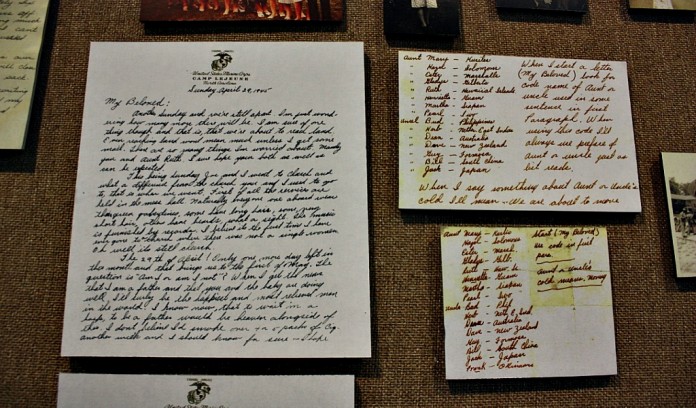ASHTABULA, Ohio — War letters line the display gallery of the Ashtabula Arts Center, the words within the letters communicate the battlefield, homefront and a range of emotions.
“There is heart, horror and humor in these letters,” said Amanda Fraizer, marketing and public relations director.
The exhibit was inspired by the play, If All the Sky Were Paper by Andrew Carroll. Meeghan Humphrey, executive director and former visual arts director of the center developed the idea.
If All the Sky Were Paper runs for one more weekend, Oct. 7-9. Advance sale tickets are $15 for adults, $13 for seniors, students and military and $11 for children 12 and under; for tickets at the door add $2.
There are free tickets are still available for active duty and veterans, call to purchase or claim free tickets 440-964-3396.
Carroll is also the founding director of the Center for American War Letters at Chapman University in Orange, California.
This national effort has amassed approximately 100,000 previously unpublished letters and emails from every war in U.S. history, from all 50 states and 40 countries.
Local effort

The Ashtabula Arts Center teamed up with the Ashtabula County District Library and collected letters and pictures from May through Sept. 3, 2016.
The library had just launched the Ashtabula Memory Project and this gathering of war letters will also serve as the inaugural collection for the new memory project, said Fraizer.
“We didn’t expect as many people to respond,” Fraizer said.
In all, they had 24 contributors, sharing more than 600 pieces; photos, letters, envelopes, etc. All the contributors are from Ashtabula County, but the letter authors are from various places, Fraizer said.
They received correspondence from the Civil War to Afghanistan, with the most coming from World War II and the least from the Vietnam and Korean Wars.
The letters give a look into life serving in foreign countires, uncertanty and family dynamics — insights that reveal the ways war affected our culture, Fraizer said.

Coded letters
One of the most interesting pieces in the collection is from a husband and wife team who coded their letters. What makes this unique is that the two handwritten keys to the code are also on display.
The letters were between Bert C. Drennen and Ethel Mae (Mitzi) Drennen.
Within the code, each family member’s name is equated to a different location. If Bert was going to signal to Ethel a new location, he would start the letter “My Beloved” so she would know to look for a name within the letter revealing where he was stationed.
The couple’s letters range from April 1942 to May 1945, which includes when their first son was born.
One of the keys to the code is in great shape on a piece of paper, the other you can see the folds, bends and creases in the paper reflecting that Bert would have keep is key folded up and tucked away in a pocket, not to be discovered.
Even today, letters and emails from U.S. service men and women are censored. Throughout the display, you will see areas crossed out or inserted comments from a censor.
“Story telling is important to art and especially this display. Our community cares about hearing these stories,” Fraizer said. “War didn’t define these peoples’ lives, but these letters are about personal life and the impacts of war.”
The letters will have a two-month stint on display, ending Oct. 30. After the exhibit comes down, it will be stored in their archive for future educational sharing, said Fraizer.
Toilet paper

Another interesting letter contributed to the art center was written on toilet paper. The letter was from Stanley W. Meredyk to his sister, Jean Meredyk. Sgt. Meredyk was captured by the German Army in Germany and remained a prisoner for eight months.
When he was rescued, he was able to send his sister the letters he had written on toilet paper while in captivity.
Grief
Not all the letters lead to such freedom. There is a set of letters from Henryetta and John Cokor Sr. to John Cokor Jr. informing Cokor Jr. of the death of his best friend Marco Baruzzi in Vietnam. These letters are stained with tears.
From the joy of birth to the grief of death, these letters portray the life of those deployed in service. All the items collected for this display have also been digitally archived in Ashtabula County Library’s memory project, to be preserved for years to come.
The arts center continuously features local artists’ work along and serves as an educational outlet for the community.
Details. The gallery is open to the public free of charge; Ashtabula Arts Center, 2928 West 13th Street, Ashtabula.












